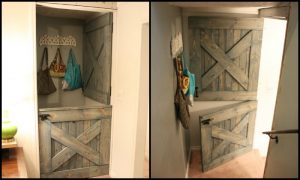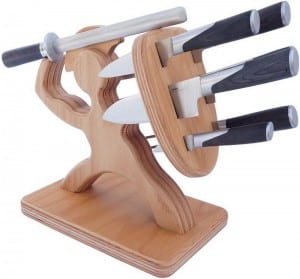Last Updated on January 26, 2024 by teamobn
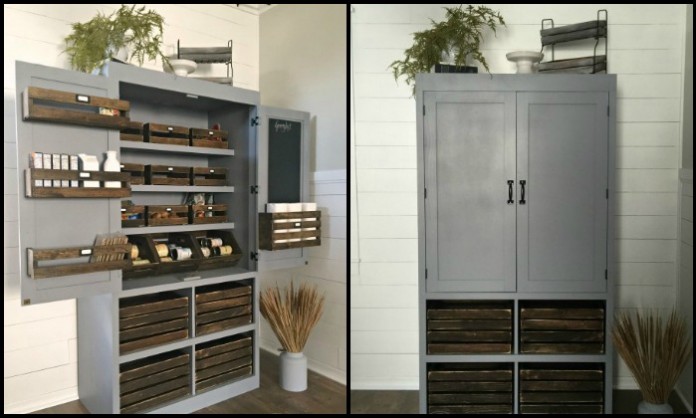
Who says you need ample space to have a pantry? if you’re struggling with a tiny kitchen and need some extra storage, why not try making a freestanding pantry?
This DIY project is legit fun and will keep your stuff organized even if your space is small. All you need is some materials and design skills, and you can whip up a pantry that’s trendy and functional.
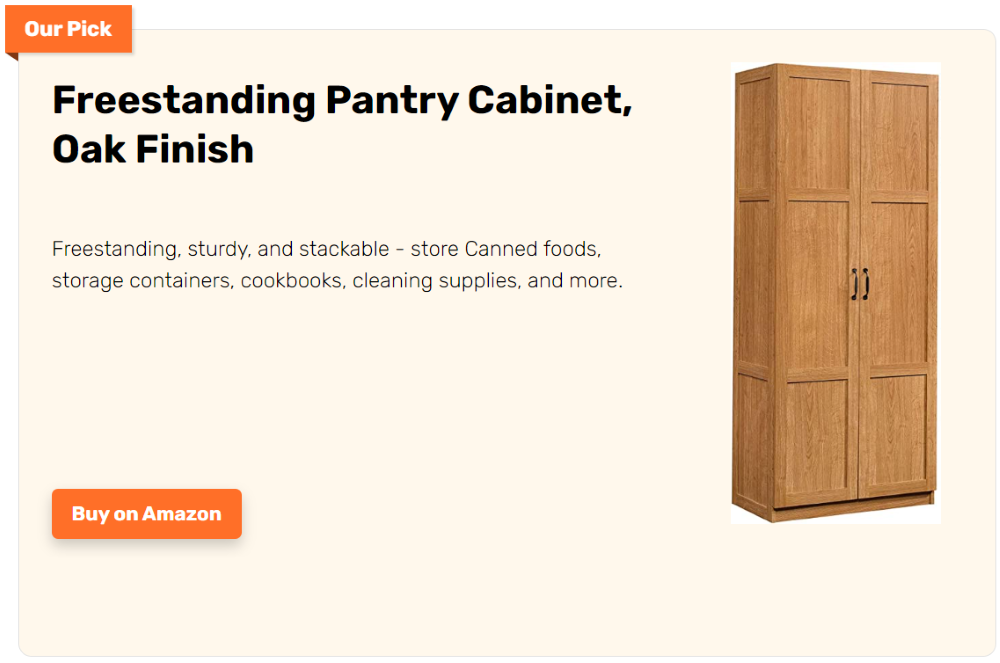
You can also do this project if you’re looking for storage for your arts and crafts materials or other items. If you have items such as hobby equipment, gardening tools, or even children’s toys, the freestanding pantry can also be a practical solution.
You can customize your shelves to fit whatever you want by playing around with the size and arrangement of each compartment.
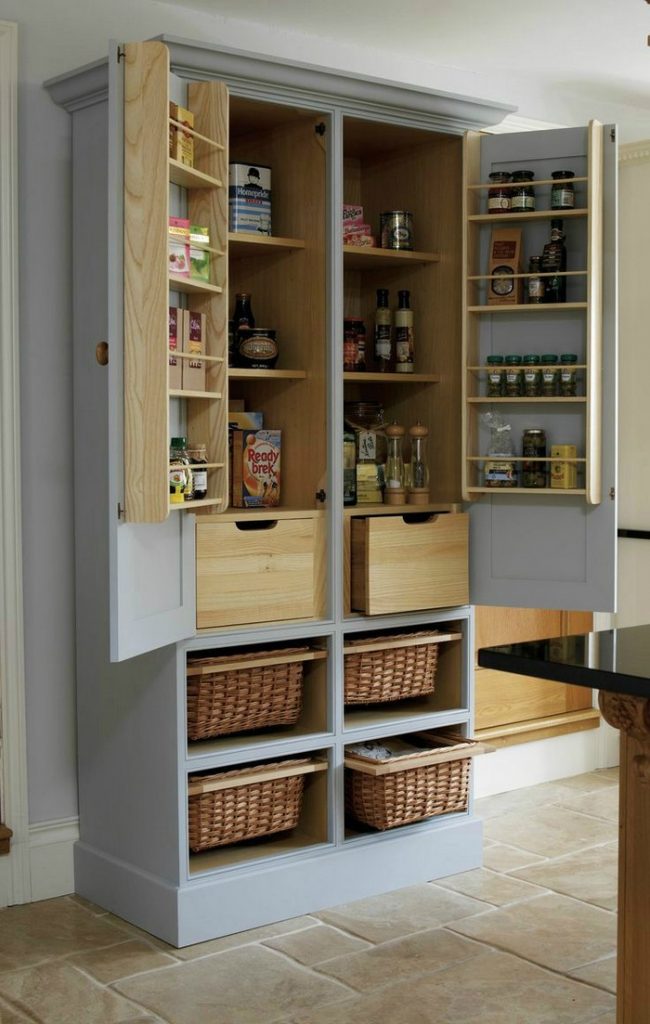
Do you need this freestanding pantry at home?
Contents
- 1 Step-By-Step Process of Constructing a Freestanding Pantry
- 2 Extra Tips
- 3 Budgeting for Your DIY Freestanding Pantry
- 4 Incorporating Freestanding Pantries in Small Apartments
- 5 FAQ on Building a Freestanding Pantry
- 5.1 What is a freestanding pantry?
- 5.2 How do I choose the right size freestanding pantry for my apartment?
- 5.3 Can a freestanding pantry be customized?
- 5.4 Are freestanding pantries expensive?
- 5.5 How can I organize my freestanding pantry efficiently?
- 5.6 What materials are used for making a freestanding pantry?
- 5.7 Is it hard to assemble a freestanding pantry?
- 5.8 How do I maintain and clean my freestanding pantry?
- 5.9 Can a freestanding pantry be used for items other than food?
- 5.10 Where is the best place to put a freestanding pantry in a small apartment?
- 6 Small Space, Big Organization!
Step-By-Step Process of Constructing a Freestanding Pantry
This guide has got you covered from start to finish with crystal clear directions and some sick tips to make your pantry pop and function like a boss.
If you’re running low on space or just want a mobile pantry to call your own, this guide is your go-to for making your pantry dreams a reality.
So, are you ready to get crafty and have some fun? Delve in!
Materials
- 2 pcs – 4×8′ 3/4″ Plywood
- 1 pc – 1×4 Wood Board
- 5 pcs – 1×2 Wood Board
- 3 pcs – 1×3 Wood Board
- 1 pc – 4×8′ 1/4″ Paneling
- 1/4″ MDF Paneling
- 6 pcs – Non-Mortise Butt Hinges for 3/4″ Door
- 2 Door Handles
- Double Magnetic Catch
- 2″ 16 gauge Finish Nails
- 1 1/2″ Pocket Hole Screws
- Wood Glue
- Wood Filler
- Crates
- Wood Stain
- Paint
Tools
- Measuring Tape
- Pencil
- Kreg Jig
- Cordless Drill
- Table Saw
- Miter Saw
- Finish Nailer
- Sander
- Safety Glasses and Ear Protection
Click on any image to start the lightbox display. Use your Esc key to close the lightbox.![]()
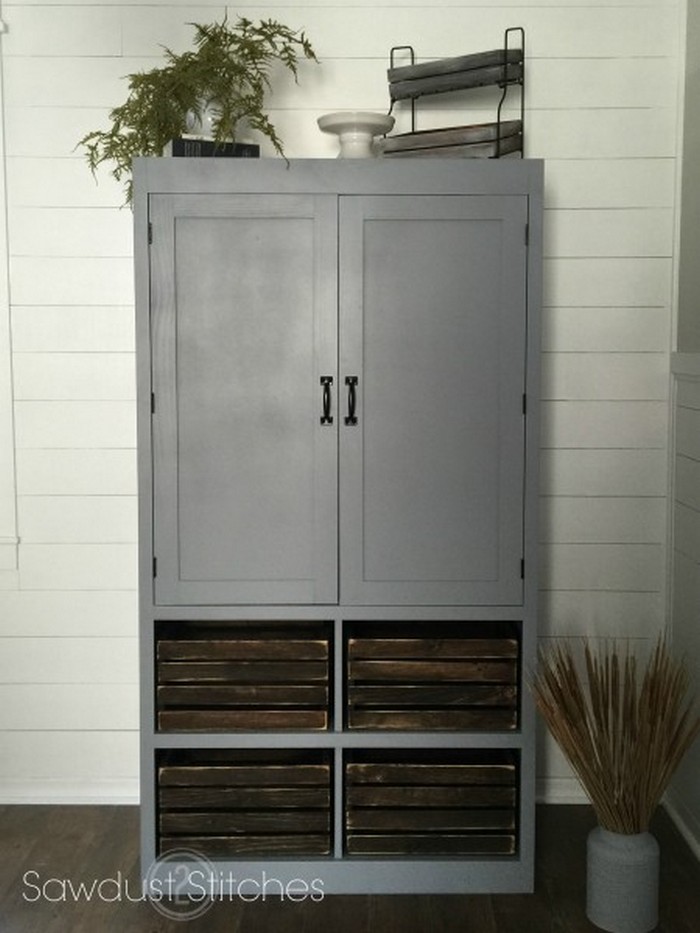
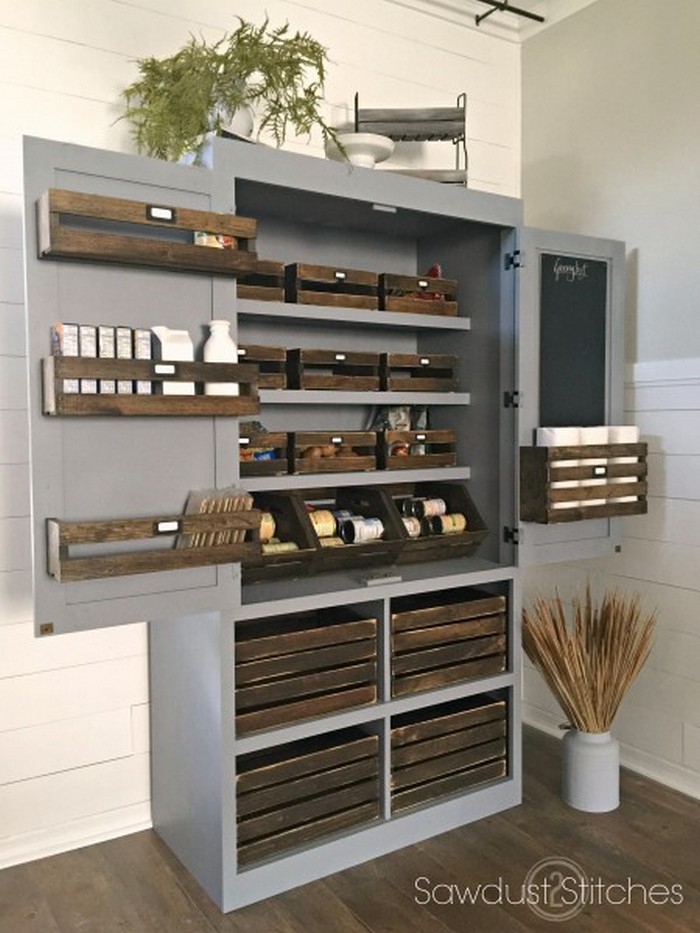

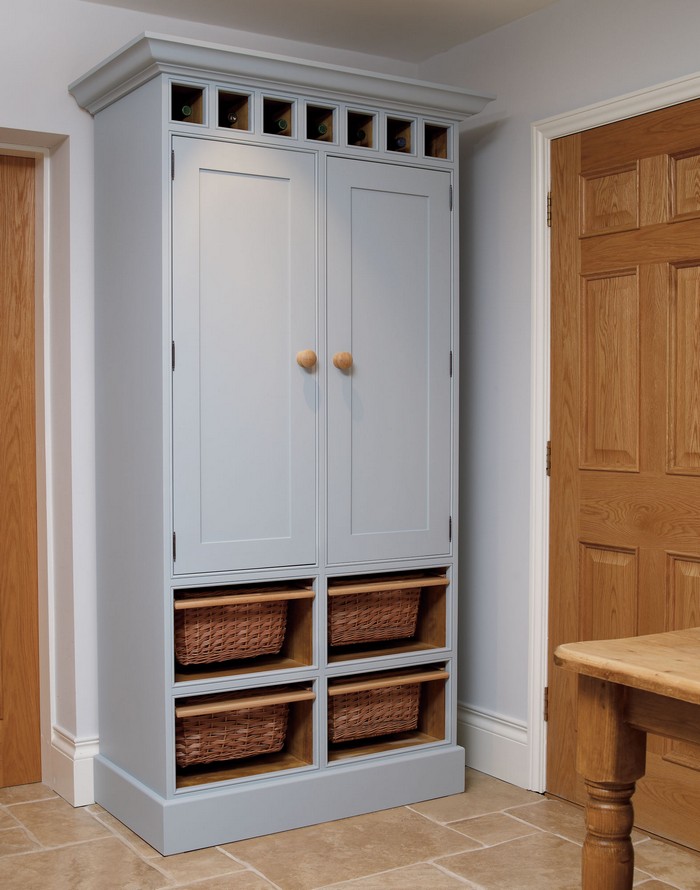
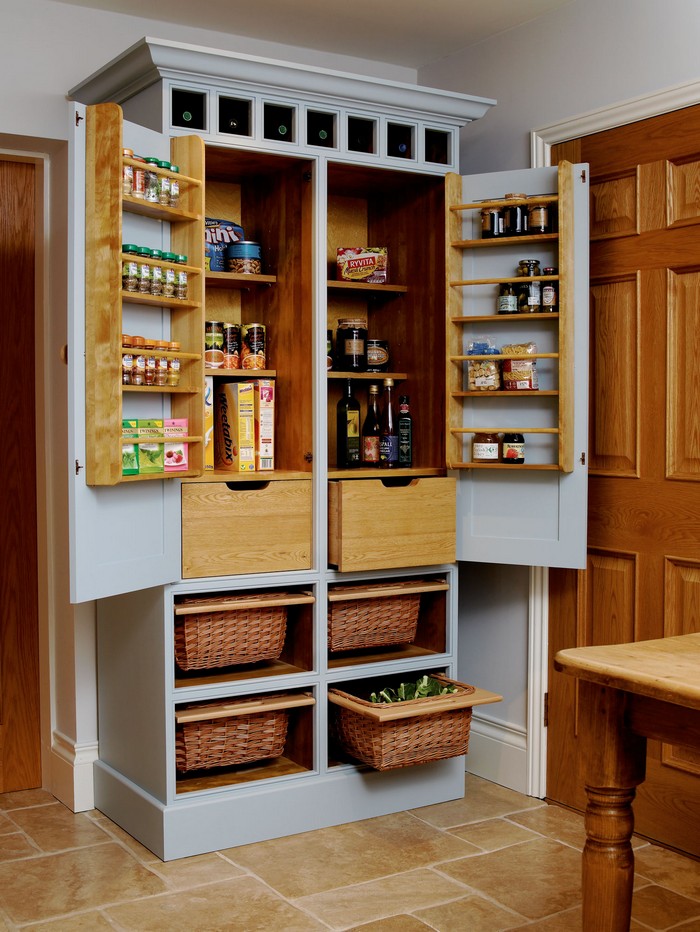
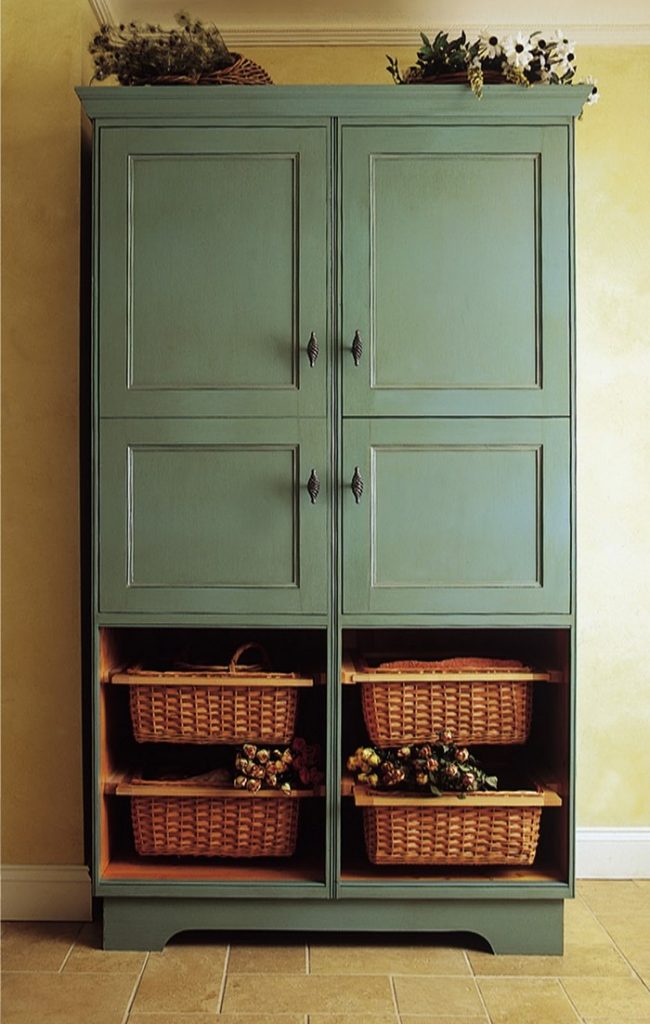
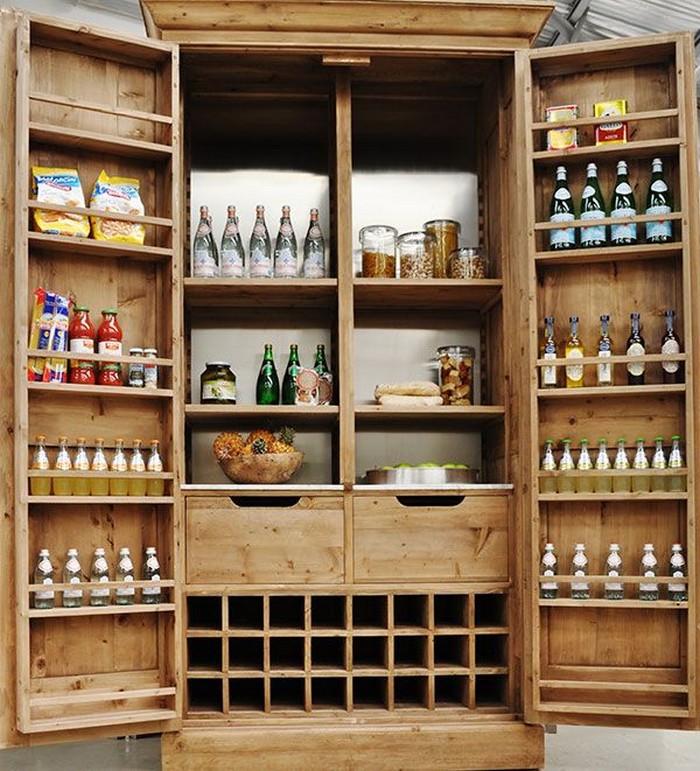

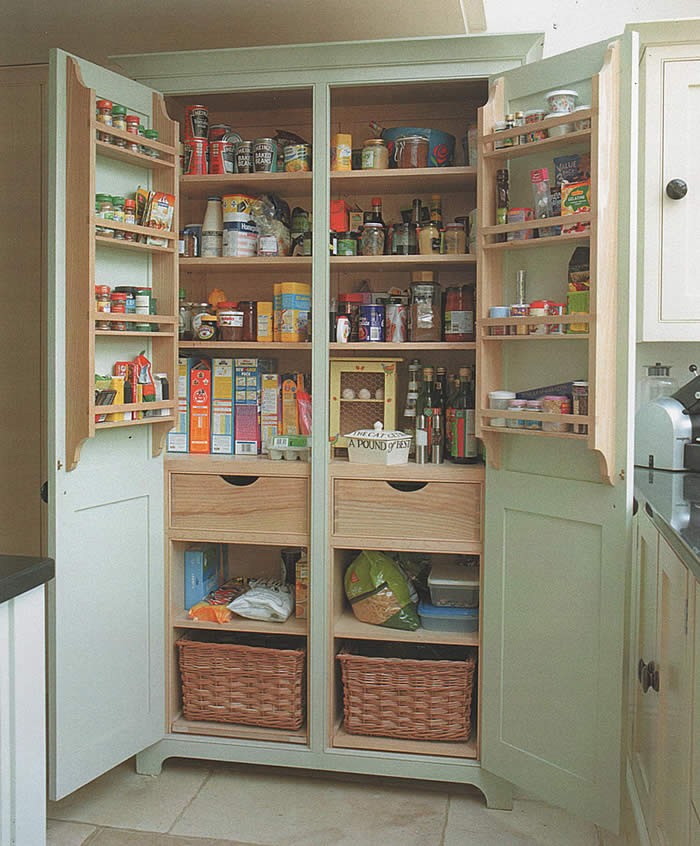
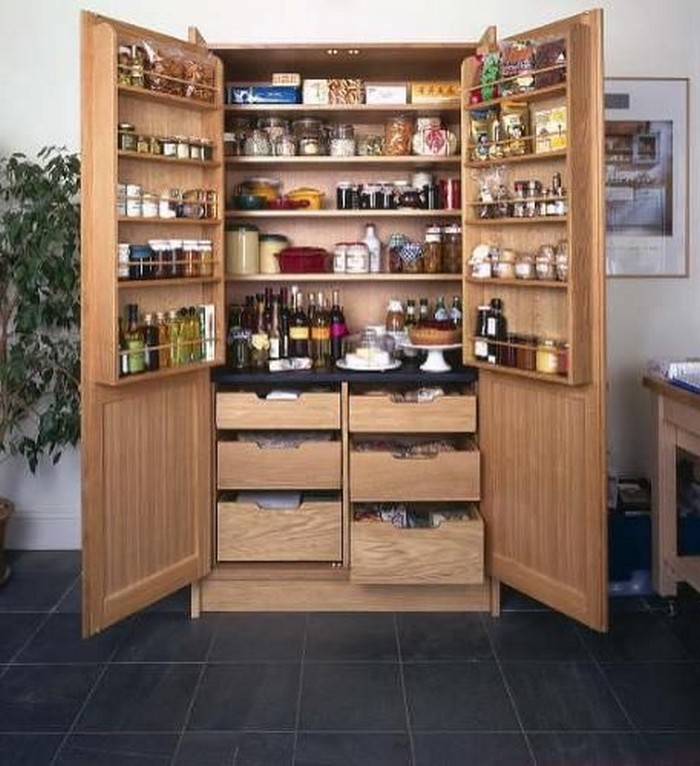
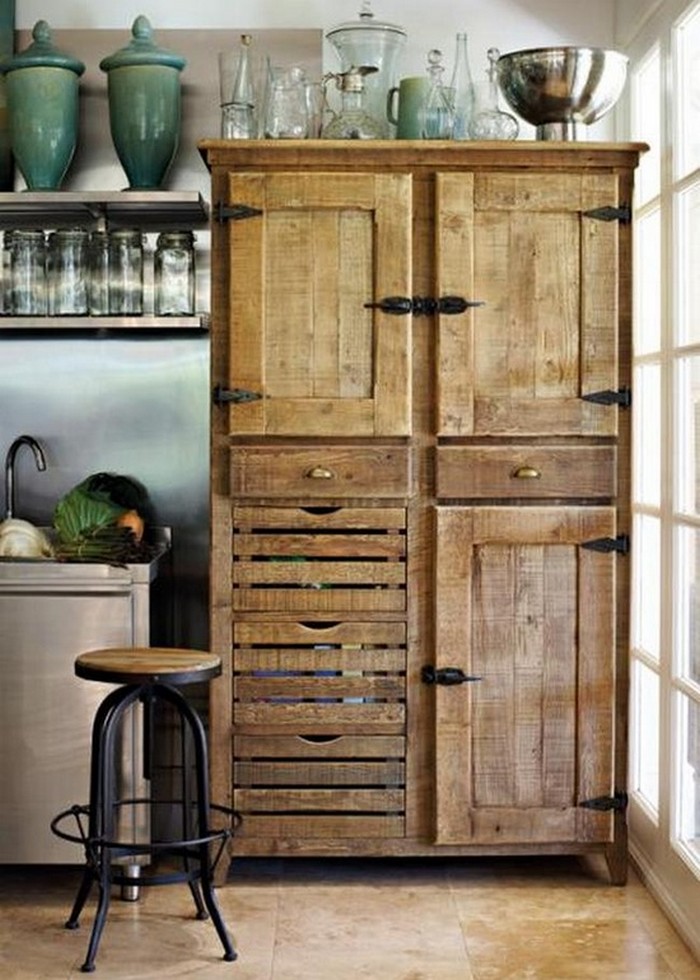
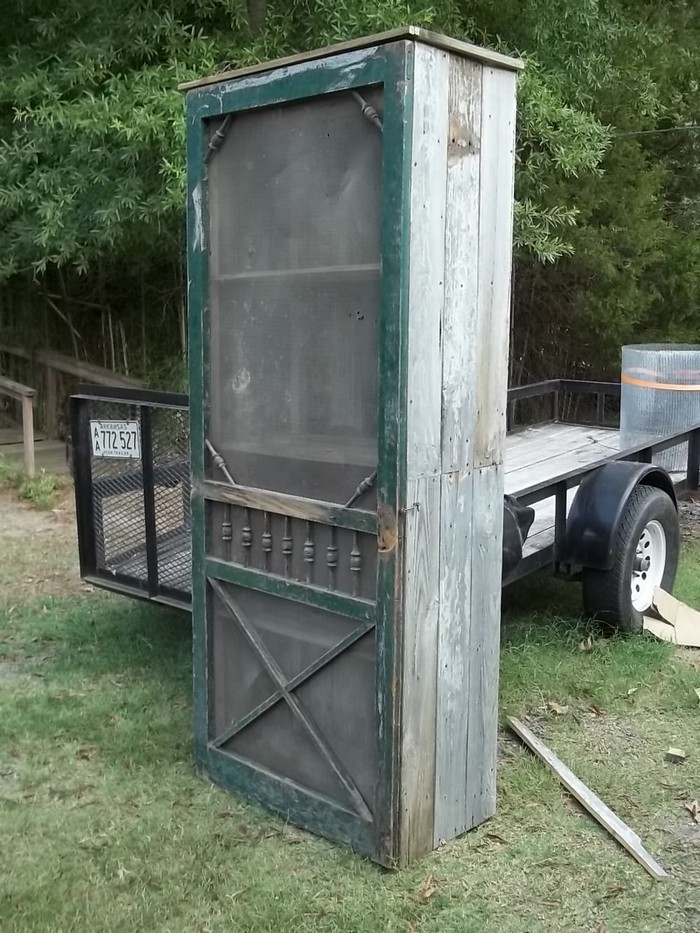
Steps
Planning and Design:
- Sketch the design of your pantry considering dimensions and the number of shelves.
- Ensure it fits the space where you plan to place it.
Cutting the Plywood:
- Using the table saw, cut the 3/4″ plywood for the sides, top, bottom, and shelves of the pantry.
- Cut the 1/4″ paneling to size for the back of the pantry.
Assembling the Frame:
- Lay out the cut pieces for the sides, top, and bottom.
- Use the Kreg Jig to drill pocket holes.
- Assemble using pocket hole screws and wood glue.
Adding the Back Panel:
- Attach the 1/4″ paneling to the back.
- Use the finish nailer and 2″ nails for a secure fit.
Installing Shelves:
- Measure and mark the placement for your shelves.
- Use the 1×2 wood boards as shelf supports, attaching them with screws and glue.
- Place the shelves on the supports and secure them.
Building the Doors:
- Use the remaining plywood and MDF paneling to construct the doors.
- Measure and cut to fit the opening of the pantry.
- Attach the non-mortise butt hinges to the doors and pantry frame.
Adding Door Features:
- Install the door handles and double magnetic catch for closure.
Sanding and Finishing:
- Sand the entire pantry, including edges and surfaces.
- Fill any gaps with wood filler, then sand again once dry.
Staining and Painting:
- Apply wood stain or paint as desired.
- Allow ample time for drying.
Final Touches:
- If using, attach crates for additional storage.
- Double-check all screws and hinges for security.

Extra Tips
So, you’ve figured out how to make your freestanding pantry. Pretty neat, right? But let’s be real, there are always ways to make it even better. Like, maybe it could be more practical or look even nicer.
Elevate your freestanding pantry to new heights with these invaluable extra tips that will take your organization’s game to the next level:
1. Utilize Door Storage
Make the most of the pantry doors by adding hooks or racks to store frequently used items like aprons, kitchen towels, or shopping bags. Door storage adds extra space and keeps your pantry organized.
Opt for over-the-door racks that can be easily installed on the pantry doors. These racks typically feature multiple tiers or shelves where you can store cleaning supplies or even small pantry items like spice jars. They make efficient use of vertical space and keep your pantry well-organized.
2. Add Lighting
Consider adding lighting inside the pantry to illuminate the shelves, making it easier to locate items, especially in dimly lit spaces or during nighttime.
Battery-operated motion sensor lights are a convenient option for illuminating your pantry shelves. These lights automatically turn on when they detect motion, ensuring that the pantry is well-lit whenever you open the door. They are easy to install and require no electrical wiring.
3. Add a Chalkboard or Whiteboard
Introduce a touch of practicality and creativity to your freestanding pantry by incorporating a chalkboard or whiteboard onto the pantry door or wall. This simple addition serves as a versatile space for jotting down grocery lists, meal plans, important reminders, or any other notes that keep you organized and on top of your pantry inventory.
Ensure that essential information remains visible and easily accessible whenever you need it. Having a designated space for jotting down notes, you can effortlessly keep track of items that need restocking, plan your meals effectively, or even showcase inspiring recipes or weekly menus.
4. Personalize the Design
Add your unique touch to the pantry’s aesthetics by painting it in your favorite colour or adding decorative elements that align with your kitchen’s style.
Choose a paint color that resonates with your taste and complements the overall design of your kitchen. Whether you prefer bold and vibrant hues or soft and muted tones, painting the pantry walls or shelves in your favorite color can instantly elevate its visual appeal and make it a standout feature in your kitchen.
Upgrade the look of your pantry by replacing the standard handles or knobs with decorative hardware that suits your style. Choose from a wide variety of options, such as antique-inspired pulls, modern minimalist handles, or unique and eclectic designs. The hardware can serve as a focal point and enhance the overall aesthetics of your pantry.
5. Regular Maintenance
Dedicate time to regularly cleaning your pantry shelves, drawers, and surfaces. Remove all items, wipe down the shelves with a damp cloth, and vacuum or sweep any crumbs or debris. This practice helps maintain cleanliness and prevents the buildup of dirt or pests.
Ensure that your pantry is kept at appropriate temperature and humidity levels to preserve the freshness and quality of stored items. Avoid placing your pantry near sources of heat or in areas prone to excessive moisture.
Regularly inspect the structural integrity of your pantry, including shelves, drawer glides, and hardware. Repair or replace any damaged components promptly to maintain the stability and functionality of your pantry.
By incorporating these extra tips into your freestanding pantry project, you’ll create a well-organized, efficient, and visually appealing storage space that perfectly complements your kitchen and makes daily meal preparations a breeze.
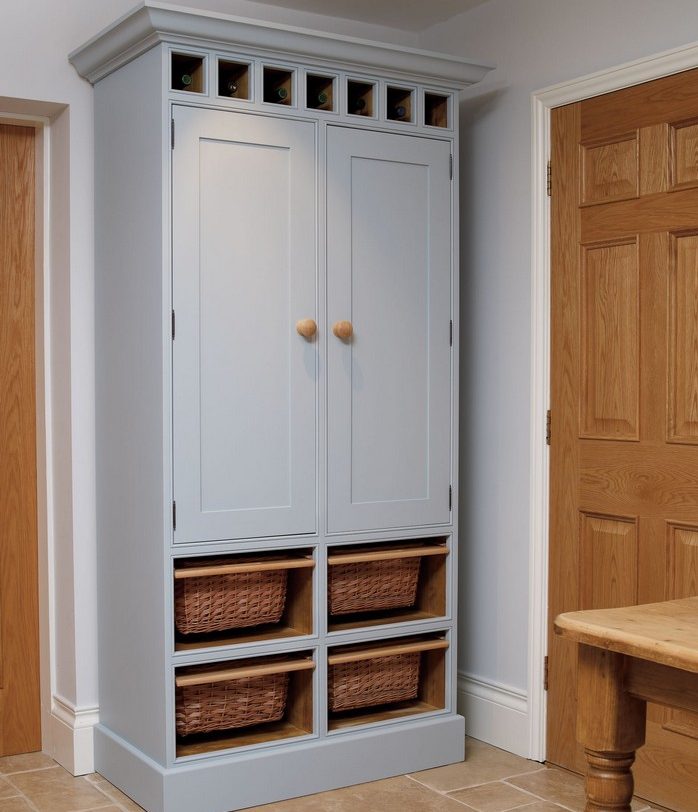
Budgeting for Your DIY Freestanding Pantry
Embarking on a DIY project to build a freestanding pantry can be exciting and cost-effective. Proper budgeting ensures that your freestanding pantry meets your needs without breaking the bank. Here’s how you can budget effectively for your DIY freestanding pantry.
Estimating Material Costs
First, list all the materials needed for your freestanding pantry. Prices for plywood, wood boards, hinges, handles, and other supplies can vary. Research local hardware stores or online retailers for the best deals. Don’t forget to include paint, wood stain, and smaller items like screws and nails in your budget.
Tool Expenses
If you don’t have the necessary tools, such as a table saw or a drill, consider the cost of purchasing or renting them. Sometimes, borrowing from a friend or neighbor can be a budget-friendly option for your freestanding pantry project.
Factoring in Additional Costs
Remember to account for unexpected expenses. This might include extra materials in case of mistakes or additional decorative elements to enhance your freestanding pantry. A contingency fund of around 10-15% of your total budget is advisable.
DIY vs. Professional Costs
Compare the cost of DIY to hiring a professional. Building a freestanding pantry yourself can save labor costs. However, if complex skills are required, getting a quote from a professional might be beneficial for comparison.
Long-term Value
Consider the long-term value of your freestanding pantry. A well-built pantry can last for years, offering excellent storage solutions. This perspective can justify a slightly higher upfront investment in quality materials.
Budget-Friendly Tips
- Look for sales or discounts on materials.
- Repurpose or recycle materials where possible.
- Do thorough research and plan extensively to avoid costly mistakes.
By carefully planning and budgeting, you can build a functional and aesthetically pleasing freestanding pantry that enhances your space without overspending. This approach ensures that your DIY project is both satisfying and financially responsible.
Incorporating Freestanding Pantries in Small Apartments
Living in a small apartment often means getting creative with storage solutions. A freestanding pantry can be a game-changer, offering extra space without the need for built-in cabinetry. Here’s how to seamlessly incorporate a freestanding pantry into a small apartment setting.
Assessing Your Space
Start by closely examining your apartment’s layout. Look for areas that are currently underused. Ideal spots for a freestanding pantry might include corners of the kitchen, dining area, or even a hallway close to the cooking space. Measure the height, width, and depth of the potential spot.
This helps in choosing a pantry that fits well without obstructing pathways or overwhelming the room. Consider the pantry’s proximity to power outlets if you plan to place appliances on or near it. Ensure the chosen location is easily accessible and doesn’t interfere with the kitchen’s workflow.
Choosing the Right Design
Selecting the appropriate freestanding pantry design is crucial for small apartments. Prioritize models that offer maximum storage while taking up minimal floor space. Tall, narrow units are often ideal for such settings. Look for designs that feature adjustable shelves, which allow for the storage of items of varying sizes, from canned goods to bulkier appliances.
Consider the style and color of the pantry – it should harmonize with your apartment’s existing décor. If your space has a modern vibe, go for sleek, minimalist designs. For more traditional spaces, a pantry with classic wood finishes might be more suitable. Remember, the pantry should be aesthetically pleasing as well as functional, as it will be a visible part of your living space.
Multifunctional Features
In small apartments, every piece of furniture should ideally serve more than one purpose. A freestanding pantry with a countertop provides extra prep space, which is a boon in a small kitchen. This counter can also be used to house frequently used appliances like coffee makers or toasters, freeing up valuable kitchen counter space.
Some pantries come equipped with additional features like built-in spice racks, hooks for hanging kitchen towels or utensils, and even pull-out boards that can be used as additional work surfaces. These multifunctional aspects make the freestanding pantry not just a storage unit, but a comprehensive kitchen utility piece.
Organizational Strategies
Effective organization within your freestanding pantry is key to maximizing its utility. Start by grouping similar items together. This approach not only makes items easy to find but also helps in tracking your inventory. Utilize baskets or bins to keep things neat and prevent smaller items from getting lost. Transparent containers are excellent for quickly spotting what you need. They also help in maintaining freshness for items like cereals, pasta, and snacks.
Consider using shelf risers and stackable storage solutions to take full advantage of the vertical space in your freestanding pantry. This technique is especially helpful in maximizing storage in small apartments. Labeling shelves and containers further enhance organization, making your freestanding pantry a model of efficiency and convenience.
Aesthetic Integration
While functionality is paramount, the aesthetic appeal of your freestanding pantry is equally important, especially in smaller living spaces where it can become a focal point. Choose a pantry that complements the color scheme and style of your existing furniture and decor. For instance, a white or neutral-colored pantry can blend seamlessly into most decors, while a bold-colored pantry can serve as an accent piece.
Enhance the look of your freestanding pantry by adding decorative elements that reflect your personal style. Placing plants, framed pictures, or artwork on top of the pantry can integrate it into your living space, making it feel like a part of your home rather than just a storage unit.
Mobility Considerations
In a small apartment, flexibility in furniture arrangement can be vital. Opting for a freestanding pantry with wheels adds incredible versatility to your space. This mobility allows you to easily move the pantry around, whether it’s for cleaning purposes, reconfiguring your space, or accessing different areas of your apartment.
A wheeled freestanding pantry is particularly useful in multipurpose spaces where you might need to clear the area for entertaining or other activities. When selecting a pantry with wheels, ensure they are sturdy and lockable for safety and stability when the pantry is in use.
Maximizing Visibility and Access
Proper visibility and accessibility are crucial for the practical use of your freestanding pantry. Good lighting plays a vital role in this. If the pantry is placed in a poorly lit area, consider adding battery-operated, motion-sensor lights inside the pantry or attaching an LED light strip under each shelf. This will help you quickly find what you need, even in low-light conditions.
Organize items in a way that frequently used items are easily reachable. Using shelf liners not only protects the surfaces but also makes cleaning spills and crumbs easier. Maintain a clutter-free arrangement in your freestanding pantry, regularly decluttering and reorganizing items to ensure everything is accessible and easy to find.
Adding a freestanding pantry into your small apartment, can significantly enhance your storage capacity and kitchen functionality. This addition proves that even in limited spaces, efficient and stylish solutions are possible.
FAQ on Building a Freestanding Pantry
What is a freestanding pantry?
A freestanding pantry is a standalone piece of furniture used for extra storage in the kitchen or other areas of your home. Unlike built-in pantries, it’s not fixed to a wall and can be moved.
How do I choose the right size freestanding pantry for my apartment?
Measure the space where you plan to place the pantry. Consider both the floor area and the height. A tall, narrow freestanding pantry works well in small spaces, maximizing storage without taking up too much floor space.
Can a freestanding pantry be customized?
Yes, many freestanding pantries can be customized. You can adjust shelf heights, add or remove features like hooks or racks, and choose from different finishes and colors to match your decor.
Are freestanding pantries expensive?
The cost of a freestanding pantry varies based on size, material, and design. There are affordable options available, and you can also save money by building your own.
How can I organize my freestanding pantry efficiently?
Use baskets, bins, and transparent containers to group similar items. Utilize vertical space with shelf risers. Labeling shelves and containers also helps in maintaining an organized freestanding pantry.
What materials are used for making a freestanding pantry?
Freestanding pantries are typically made from materials like wood, MDF, metal, or a combination of these. The choice depends on your budget, style preference, and the weight of items you plan to store.
Is it hard to assemble a freestanding pantry?
This depends on the model. Some freestanding pantries come pre-assembled, while others require some assembly. DIY kits usually come with instructions and can be a fun project.
How do I maintain and clean my freestanding pantry?
Regularly wipe down the surfaces with a damp cloth. For wooden pantries, use wood-safe cleaners. Avoid harsh chemicals, and if your pantry has wheels, check and clean them periodically for smooth movement.
Can a freestanding pantry be used for items other than food?
Absolutely. A freestanding pantry is versatile and can be used to store various items like crafts, small appliances, linens, or even books.
Where is the best place to put a freestanding pantry in a small apartment?
The best location for a freestanding pantry in a small apartment is near the kitchen or dining area. Look for underutilized spaces like corners or alongside existing cabinetry. Ensure it doesn’t obstruct the flow of the room.
Small Space, Big Organization!
The guide begins by addressing the challenges of limited storage and highlights the benefits of a freestanding pantry. It encourages you to assess space and storage needs, enabling you to plan a customized pantry design.
From selecting materials and tools to step-by-step construction, the guide offers detailed instructions for building a sturdy and functional pantry. Additionally, it provides valuable organizational tips, emphasizing using storage containers and space-saving techniques.
With regular maintenance, the freestanding pantry becomes an efficient and clutter-free haven, elevating kitchen organization and overall culinary experiences.
Now, ready to transform small spaces into an oasis of organization and convenience? Time to get building and start some sweet organization with a freestanding pantry!
For creative organization projects, check out our pantry cabinet ideas.


